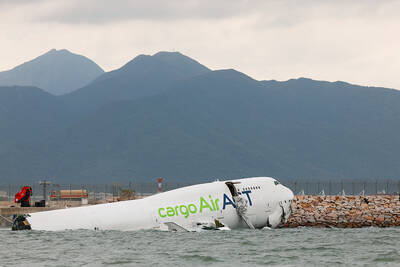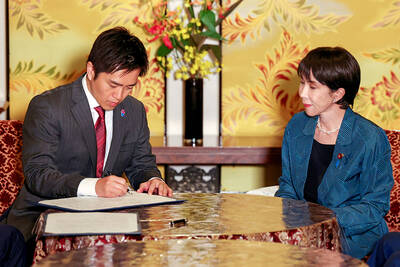The Inner Mongolian Autonomous Region in China has approved a massive power project that would use solar and wind to produce green hydrogen.
The Inner Mongolian Energy Administration has given the go ahead to a cluster of plants in the cities of Ordos and Baotou that would use 1.85 gigawatts (GW) of solar and 370 megawatts (MW) of wind to produce 60,691 tonnes of green hydrogen a year, the Hydrogen Energy Industry Promotion Association said in a report.
Development is scheduled to begin in October and the projects would be operational in mid-2023, the association said, without specifying the cost or the developers.
The project, which would produce enough hydrogen output to displace about 681.37 million liters of gasoline a year if it were used for fuel-cell vehicles, is the biggest yet to be spearheaded by the Chinese government, BloombergNEF analyst Wang Xiaoting (王瀟婷) said.
China’s booming hydrogen industry still has bottlenecks — including how the fuel is stored and used — which need to be tackled in the next five years, Securities Daily said in an article yesterday.
Less than 20 percent of the power from the Inner Mongolian development would go to the grid, with the rest dedicated to green hydrogen.
While several projects have been announced in China that combine renewables with green hydrogen, most are intended for electricity generation first, with the hydrogen component just window dressing to help get approval, Wang said.
However, the project would require at least 465MW of electrolyzers to produce that much hydrogen, she said, adding that global electrolyzer shipments were just 200MW last year and are forecast to be 400MW this year.
“These projects will install more electrolyzers than the entire global market in 2021,” Wang said.
Hydrogen is widely viewed as vital to China’s drive to decarbonize its economy by 2060.
The output value of the country’s hydrogen industry is forecast at 1 trillion yuan (US$154.3 billion) in five years’ time and could reach 12 times that by 2050, Bloomberg Intelligence has said, citing China Hydrogen Alliance projections.
The biggest Chinese green hydrogen projects have so far come from industrial giants such as Sinopec or Ningxia Baofeng Energy Group, which is set to complete a 150MW solar-powered electrolyzer array this year at one of its coal-to-chemical plants.
China Baowu Steel Group has announced plans for 1.5GW of renewable-powered electrolyzers, without providing timing.
While Inner Mongolia has long been one of the leading coal mining regions in China, officials are positioning it as a potential renewable energy hub to distribute electricity and hydrogen to the rest of the country.
The region receives about 3,100 hours of sunlight a year for solar generation, and is located on the main channel of Siberian wind that could power dozens of gigawatts of wind turbines, the association said.

Indonesia was to sign an agreement to repatriate two British nationals, including a grandmother languishing on death row for drug-related crimes, an Indonesian government source said yesterday. “The practical arrangement will be signed today. The transfer will be done immediately after the technical side of the transfer is agreed,” the source said, identifying Lindsay Sandiford and 35-year-old Shahab Shahabadi as the people being transferred. Sandiford, a grandmother, was sentenced to death on the island of Bali in 2013 after she was convicted of trafficking drugs. Customs officers found cocaine worth an estimated US$2.14 million hidden in a false bottom in Sandiford’s suitcase when

CAUSE UNKNOWN: Weather and runway conditions were suitable for flight operations at the time of the accident, and no distress signal was sent, authorities said A cargo aircraft skidded off the runway into the sea at Hong Kong International Airport early yesterday, killing two ground crew in a patrol car, in one of the worst accidents in the airport’s 27-year history. The incident occurred at about 3:50am, when the plane is suspected to have lost control upon landing, veering off the runway and crashing through a fence, the Airport Authority Hong Kong said. The jet hit a security patrol car on the perimeter road outside the runway zone, which then fell into the water, it said in a statement. The four crew members on the plane, which

Japan’s ruling Liberal Democratic Party (LDP) and its junior partner yesterday signed a coalition deal, paving the way for Sanae Takaichi to become the nation’s first female prime minister. The 11th-hour agreement with the Japan Innovation Party (JIP) came just a day before the lower house was due to vote on Takaichi’s appointment as the fifth prime minister in as many years. If she wins, she will take office the same day. “I’m very much looking forward to working with you on efforts to make Japan’s economy stronger, and to reshape Japan as a country that can be responsible for future generations,”

SEVEN-MINUTE HEIST: The masked thieves stole nine pieces of 19th-century jewelry, including a crown, which they dropped and damaged as they made their escape The hunt was on yesterday for the band of thieves who stole eight priceless royal pieces of jewelry from the Louvre Museum in the heart of Paris in broad daylight. Officials said a team of 60 investigators was working on the theory that the raid was planned and executed by an organized crime group. The heist reignited a row over a lack of security in France’s museums, with French Minister of Justice yesterday admitting to security flaws in protecting the Louvre. “What is certain is that we have failed, since people were able to park a furniture hoist in the middle of